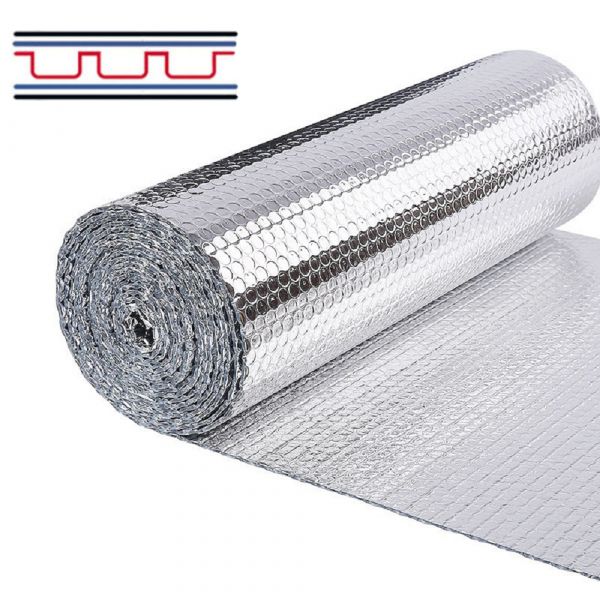5 Innovative Ways to Use Aluminum Bubble Foil Heat Reflective Insulation for Energy Efficiency
In today’s energy-conscious world, homeowners and builders alike are on the hunt for effective solutions to reduce energy consumption and lower utility bills. One such solution is aluminum bubble foil heat reflective insulation. This versatile material not only enhances energy efficiency but also provides practical insulation options for various parts of your home. In this article, we’ll explore five innovative ways to use aluminum bubble foil heat reflective insulation, providing actionable tips and expert insights to help you achieve a more energy-efficient living space.

1. Reflective Roof Insulation
How It Works
Aluminum bubble foil heat reflective insulation is designed to reflect radiant heat away from your home. When installed on your roof, the reflective surface bounces back a significant portion of the sun’s heat, reducing the amount of thermal energy that penetrates your living space. This method is particularly beneficial during hot summer months, as it can keep your home cooler and reduce the strain on your air conditioning system.
Installation Tips
- Clean Surface: Ensure your roof is clean and free of debris before installation.
- Proper Sealing: Use high-quality adhesives or fasteners to secure the insulation material.
- Air Gap: Maintain an air gap between the insulation and the roof surface to maximize reflective efficiency.
- Professional Help: Consult with an insulation expert if you’re unsure about the installation process.
By incorporating these tips, you can ensure that your roof installation is both efficient and durable, leading to long-term energy savings.
2. Enhancing Attic Insulation and Ventilation
Benefits of Attic Insulation
Attics are notorious for losing energy if not properly insulated. Installing aluminum bubble foil heat reflective insulation in your attic can help regulate the temperature, keeping your home warmer in the winter and cooler in the summer. The insulation reflects heat back into the living space during colder months, reducing the need for excessive heating.
Improving Airflow for Better Efficiency
A well-ventilated attic works hand-in-hand with insulation to optimize energy efficiency. Consider these steps:
- Install Vents: Ensure proper placement of ridge and soffit vents.
- Regular Maintenance: Clean and inspect your attic ventilation system periodically.
- Use Fans: In larger attics, consider installing exhaust fans to improve air circulation.
According to the U.S. Department of Energy, proper attic insulation combined with effective ventilation can reduce heat loss by up to 10%, making a significant impact on your overall energy consumption.
3. Insulating Walls and Ceilings
Wall Insulation Applications
While walls are often overlooked in home insulation, they can be a major source of energy loss. Using aluminum bubble foil heat reflective insulation in wall cavities can:
- Reduce Heat Transfer: The reflective properties help to block radiant heat.
- Enhance Comfort: Maintain a consistent indoor temperature regardless of external weather conditions.
- Lower Energy Bills: By reducing the need for heating and cooling, you can enjoy noticeable savings over time.
Ceiling Insulation Benefits
Applying insulation to ceilings is another effective strategy. This is especially useful in multi-story homes where the upper floors tend to overheat during the summer. A few pointers include:
- Ease of Installation: Ceiling insulation is relatively straightforward and can be incorporated during renovations.
- Improved Acoustics: In addition to temperature control, this insulation can help dampen sound, providing a quieter living environment.
4. Underfloor Insulation Techniques
Benefits of Insulating Underfloor Areas
Insulating the area beneath your floors can provide significant energy efficiency benefits. By placing aluminum bubble foil heat reflective insulation under floors, you can:
- Prevent Heat Loss: Especially in homes with unheated basements or crawl spaces.
- Enhance Comfort: Keep floors warmer during cold months, adding to overall home comfort.
- Lower Heating Costs: Retain heat within your living spaces rather than letting it escape through the floor.
Practical Installation Steps
- Assess the Area: Determine if your underfloor space is accessible and suitable for insulation.
- Measure Accurately: Ensure you purchase enough insulation material to cover the entire area.
- Secure Properly: Use the appropriate fastening methods to keep the insulation in place over time.
These simple yet effective steps can transform a previously neglected area into a key player in your home’s energy efficiency strategy.
5. Innovative DIY Projects and Multi-Purpose Uses
Creative Applications Beyond Traditional Insulation
Beyond the standard uses in roofs, attics, walls, and floors, aluminum bubble foil heat reflective insulation can inspire a range of innovative DIY projects:
- Portable Insulated Panels: Create lightweight, insulated panels for outdoor use or temporary structures.
- Garden Greenhouses: Use the reflective properties to help maintain stable temperatures in greenhouses.
- Custom Window Inserts: Reduce heat loss during colder months by fitting custom inserts with the reflective insulation.
Combining Insulation with Other Energy-Saving Methods
Consider integrating aluminum bubble foil heat reflective insulation with other eco-friendly upgrades:
- Double-Glazing Windows: Pair insulation with energy-efficient windows for maximum impact.
- Solar Panels: The reflective surface can help direct additional sunlight towards solar collectors, enhancing their efficiency.
- Smart Home Systems: Use sensors and automation to adjust insulation settings dynamically, ensuring optimal performance at all times.
These creative projects not only boost energy efficiency but also allow you to tailor your home’s insulation to suit specific needs and lifestyles.
Expert Tips and Additional Considerations
Safety, Maintenance, and Longevity
- Regular Inspections: Schedule periodic checks to ensure the insulation remains intact and effective.
- Moisture Control: Prevent moisture buildup by ensuring proper ventilation and using vapor barriers where necessary.
- Fire Safety: Check that the insulation material meets local fire safety standards, especially if installed in high-risk areas.
Cost-Benefit Analysis and Energy Savings Statistics
Investing in aluminum bubble foil heat reflective insulation can yield significant long-term savings. For example:
- Energy Savings: Homeowners have reported reductions in energy bills of up to 15% after proper insulation upgrades.
- Return on Investment: While initial costs may vary, the long-term benefits often outweigh the upfront investment, with many users seeing a full ROI within a few years.
- Environmental Impact: Beyond cost savings, reducing energy consumption also lowers your carbon footprint, contributing to a more sustainable environment.
Conclusion
In summary, aluminum bubble foil heat reflective insulation offers a multitude of innovative applications that can transform your home into an energy-efficient haven. From reflective roof insulation to creative DIY projects, each method provides tangible benefits in terms of cost savings, comfort, and environmental impact. Here are the key takeaways:
- Versatility: The insulation can be applied in various areas of your home, including roofs, attics, walls, floors, and even DIY projects.
- Energy Efficiency: Proper installation and maintenance can significantly reduce energy consumption and lower utility bills.
- Sustainability: By reducing heat loss and promoting efficient energy use, you’re contributing to a greener planet.
Ready to take the next step towards a more energy-efficient home? Whether you’re a seasoned DIY enthusiast or a homeowner looking to reduce energy bills, explore these innovative insulation methods today. Leave your comments below, share your experiences on social media, and subscribe to our newsletter for more expert tips and home improvement guides.

